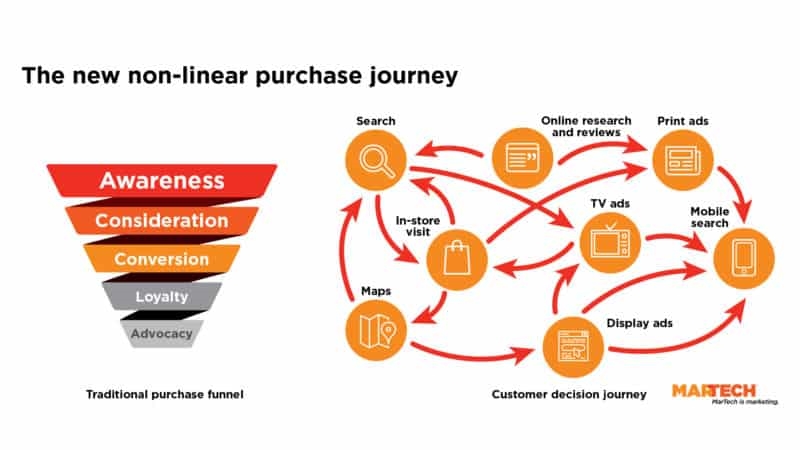Here’s why marketers need to know which channels and events contribute most to the bottom line.
Marketing attribution is an umbrella term describing the departments, people, and technology responsible for determining what marketing tactics and channels are contributing to sales, conversions, and leads. The responsibilities inherent in marketing attribution roles include:
- Understanding which channels generate the most leads, sales, and revenue.
- Identifying channels and touchpoints that refer the highest quality leads or the most valuable customers.
- Predicting/planning marketing and/or advertising spend based on past performance.
- Having a holistic understanding of the offline and online customer buying journey and weighting journey interactions appropriately.
- Running/viewing reports and providing insights based on campaign data and analytics.
- Measuring customer engagement for each touchpoint (e.g., multi-touch attribution).
In order to optimize current campaigns, and plan future ones, marketers need to know which touchpoints are effective in driving conversions. Given the complexity of today’s customer journey across digital and non-digital channels, this is an enormous challenge. The solution will have data at its core.
Marketers and C-level executives are feeling an increased demand to prove the effectiveness of their ad campaigns and marketing initiatives. For instance, 59% of marketing leaders said they face high levels of pressure from CEOs to show the impact of their efforts, according to the August 2021 CMO Survey sponsored by the American Marketing Association, Deloitte, and Duke University’s Fuqua School of Business. Marketing attribution has the potential to address this need.
In this post, we’ll cover the basics of marketing attribution — what it is, why it’s important, and how marketing and sales teams can succeed with it. Key points covered include:
- What is marketing attribution?
- Types of marketing attribution models.
- Why should marketers care about attribution?
- Who uses or works with marketing attribution tools?
- What types of tools or software enable marketing attribution?
- How marketing attribution can help marketers succeed.
- Resources for learning more about marketing attribution.
Estimated reading time: 11 minutes
What is marketing attribution?
Marketing attribution is the process of measuring and assigning credit to any channel or touchpoint that impacts a company’s pipeline and revenue. However, the problem with attribution is that both B2B and B2C customer journeys are becoming more complex.
Traditional attribution modeling relies on interpreting static ROI metrics in a dynamic marketing environment. This can lead to false assumptions — and incorrect attribution — if marketers fail to dig deeper.
A dynamic marketing environment refers to the nonlinear characteristic of the modern customer journey. It speaks to how each piece of content, interaction, and experience contributes to the culmination of the buying journey (e.g., the sale, lead, or conversion).

Tracking and measuring interactions is the easy part. Understanding the context and importance of each interaction—how it ultimately contributes to the customer’s final action — is the hard part, particularly when you’re weighing the combined impact of offline and online channels. The ability to do this well begins and ends with data, so it makes sense that the tools that facilitate marketing attribution focus on ingesting, measuring, and interpreting data.
Types of marketing attribution models
There are several different types of marketing attribution models that marketers use to assign credit to their initiatives. It’s important to understand them if you want to do marketing attribution the right way.
First-touch attribution. This model gives 100% of the credit for a conversion or sale to the first customer touchpoint. Take paid search or social clicks, for example. It’s very easy to give a paid search or social ad all the credit for a sale because it’s easy to see the click-to-sale funnel in your Google Analytics report.
But this model also relies on third-party cookies to deliver the information. (We’ll get to why that’s a problem in a bit.) It also discounts any other interactions the customer may have had before or between the ad click and the final sale. This is the model that tends to annoy your sales team since the credit is given to the channel bringing in the lead rather than the work required to close the sale.
Last-touch attribution. This gives 100% of the credit for a conversion or sale to the last touchpoint the customer interacted with before converting. Sales teams like this model because it tends to favor sales materials like eBooks, webinars, and demos over top-of-funnel touchpoints like search ads.
Multi-touch attribution. Multi-touch gives credit to every touchpoint and interaction along a customer’s buying journey that contributes to the final conversion or sale. Traditional multi-touch models tend to be linear, meaning they weigh each touchpoint equally. There’s been much debate about the value of making assumptions based on metrics alone (e.g., more leads equals more success).
In a perfect multi-touch attribution world, marketers can weigh the impact of each touchpoint based on how it influences the final sale or conversion. This is where martech tools can help.
Why should marketers care about attribution?
The only way marketers can optimize current and future campaigns is by knowing which touchpoints are effective in driving results. Given the complexity of today’s customer journey across digital and non-digital channels, this is an enormous challenge.
That some marketing dollars will inevitably be wasted is not news. Way back in 2018, nearly 30% of global marketers said they wasted nearly a third of their marketing budgets, and half wasted about 20%.
Marketing attribution promises to redirect the flow of wasted dollars from ineffective channels to those channels and tactics that are most effective. When it comes to marketing, everything is measurable.
You should care about proper marketing attribution because:
- It tells you what things you should be paying attention to and which have less value.
- It helps you predict what’s coming so you can make real-time adjustments in your marketing approach.
- It helps you spend your marketing dollars wisely.
- It empowers your marketing and sales teams to make better decisions about their budgets and time.
- It requires that marketing, sales, product, and management teams talk to each other to evaluate the customer journey holistically.
- It banishes data siloes.
However, marketing attribution isn’t a perfect science. Markets are “complex adaptive systems,” says marketing strategist Kathleen Schaub, meaning the interactions between audiences and brands can be unpredictable with so many factors creating feedback loops. Marketers must acknowledge that ROI measurement is complex and requires a combination of optimized management structures and high-quality marketing attribution tools.
Who uses or works with marketing attribution tools?
While every team in an organization benefits when they understand their company’s unique buying cycle, marketing attribution tools are generally the purview of marketing teams.
Here are some use cases that highlight these tools and how they’re used.
The CMO of a B2B company wants to understand how the latest top-of-funnel brand strategy is impacting revenue. Connecting branding initiatives to revenue is a tough exercise. It requires measuring things like brand experience and level of awareness based on interaction and engagement, ultimately tying both to sales. Tools like SproutSocial and Brandwatch can be integrated with marketing analytics platforms to understand how marketing impacts brand awareness, which impacts sales.
The CMO of a global retail chain wants to understand what paid media channels contribute to the highest-value customers. Multi-touch attribution can help this CMO understand which paid media sources deliver the highest value customers by tying the top-of-funnel tactic (e.g., search ads) to mid- and low-funnel activities (e.g., adding items to the shopping cart, initiating a chat on the e-commerce website, etc.) The goal here is to redistribute ad spend to the most effective activities without increasing the marketing budget.
The owner of a local restaurant wants to know what offers and promotions resonate best with customers. Consumer behavior data procurement is vital when making marketing decisions, and marketers need attribution tools to help identify which events in the buyer journey drive the most conversions. Attributing conversion values to specific offers, promotions, and other calls-to-action can show businesses which circumstances lead to higher levels of customer buy-in.
The CEO of a Fortune 500 tech company wants to move away from third-party data and better understand the buying journey from their customers’ perspective. Appropriate attribution requires high-quality data, but most marketers currently use third-party cookies to create, track, and optimize ad campaigns. As we move to a cookieless world, marketing attribution will increasingly rely on first-party data using tools like CDPs, identity resolution platforms, and journey orchestration engines (JOEs) to get a deep understanding of their customers’ buying journey.
The CMO of a CPG brand wants to understand if pairing certain online and offline touchpoints lift brand and/or ad recall. Marketing attribution, if done right, will enable you to unify every channel and touchpoint across the buying journey. Machine learning and AI can make these connections for you, synthesizing data from a range of sources to surface insights that can help you understand how offline touchpoints like TV and radio work with digital channels to improve campaign performance.
What types of tools or software enable marketing attribution?
Any tool that helps identify how your ads, content, and media contribute to campaign performance falls under the umbrella of marketing attribution software. But to be considered a true marketing attribution platform, a tool must contain the following features:
- It supports a broad range of online and offline channels: digital, TV, radio, OTT, podcast, and IoT to capture interactions between your customers and your brand.
- It offers “big picture” analysis by ingesting — and normalizing — data from a variety of campaigns, platforms, and sources.
- It supports statistical modeling to get more meaningful information from incomplete or imperfect data.
- It employs predictive analytics generally via AI and machine learning to help marketers plan campaigns.
- It uses a variety of different attribution models, including single-touch, multi-touch, algorithmic, custom models, etc. to support all business types.
- It has robust reporting and data visualization features that can deliver insights and reports in real-time based on user-specific KPIs and goals.
- It integrates with martech/ad tech tools, e.g., fits seamlessly with your tech stack.
- It typically has a relationship with walled-garden platforms like Amazon and Facebook to add additional data points that yield deeper insights.
Examples of marketing attribution tool capabilities
Marketers looking for tools that give them more in-depth customer touchpoint data will find a slew of helpful functions in attribution tools. Here are some of their capabilities and offerings.
Ingestion and management of offline marketing data. Although more and more marketing touchpoints are moving to digital channels, offline events still account for a large portion of most customer journeys and continue to grow. Attribution tools can help marketing account for this offline data to ensure these touchpoints don’t get lost in the mix.
A single source of truth when evaluating channel effectiveness. Since marketing attribution tools measure touchpoints from a variety of channels and platforms, they’re able to offer marketers a single source of baseline data, which helps increase their confidence in the numbers.
Increased opportunities for personalization. Attribution tools can give marketers a more accurate picture of their customers’ preferred communication mediums and channels. This valuable data makes it easier for marketers to increase personalization.
Campaign spend analysis. These tools do a great job of offering marketers insights into the channels and touchpoints that have the best ROI. This allows them to better allocate campaign spend to the most profitable areas.
Each attribution platform is different, so remember to ask vendors about their specific capabilities when evaluating your options.
How marketing attribution can help marketers succeed
Marketing attribution technology can help marketers justify budgets and plan more effective strategies without third-party cookies. Unifying customer journey data across touchpoints and channels can help marketing and sales teams deliver more value.
Marketers are beginning to understand what consumers already knew — it’s all one buying journey. According to a recent study by The Trade Desk, the number of marketers who plan to use sales data very frequently will triple in the coming year. In addition, nearly 80% of respondents said they plan to use point-of-sale data to inform their advertising activity, connecting this activity to consumer purchases that occur both in physical stores and online.
While marketing attribution relies on good data, it also requires knowledge of the current market and a multi-disciplinary approach to analyzing — and acting on — campaign performance data. Marketers who connect the dots across the entire buying journey are in a much better position to anticipate and respond to changes in the market (and in consumer behavior) than those who don’t.
Resources for learning more about marketing attribution
There are many tools and resources available that can help brands track and gain insights from each customer touchpoint. Here are some we believe will be beneficial:
- Enterprise Marketing Attribution and Predictive Analytics: MarTech examines the market for marketing attribution and predictive analytics and the considerations involved in implementation. The 29-page report reviews the growing market for marketing attribution and predictive analytics, plus the latest trends, opportunities and challenges.
- Measuring Marketing Attribution Infographic: SharpSpring partnered with Ascend2 to gather insights from marketing influencers from 130 businesses with 500 or fewer employees. The resulting quick-reference infographic is packed with easily digestible data on how businesses are developing and implementing their marketing attribution strategy.
- 16 marketing automation platforms your organization should consider: Marketing automation platforms offer numerous benefits by streamlining manual B2B marketing tasks, including lead management, email campaign development and landing page creation.
- Why marketing attribution is both a challenge and a necessity: While some are skeptical about the attribution narratives derived from touchpoint data, others insist that measuring marketing is a must.
- How marketers can measure success: Marketers can show how their actions contribute to certain outputs as long as they’re committed to measuring their work.
The post Marketing attribution: What it is, and how it identifies vital customer touchpoints appeared first on MarTech.
(36)
Report Post







